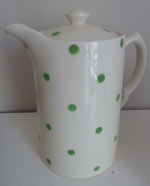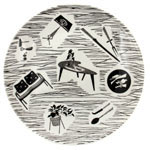 Jane Perrone guides you through the dos and don'ts of collecting vintage china. Are you a collector, and if so, what do you collect?
Jane Perrone guides you through the dos and don'ts of collecting vintage china. Are you a collector, and if so, what do you collect?I'm not sure how it started - maybe it was a chipped vase picked up at a charity shop, or just hours spent hanging around car boot sales and auction houses with my pocket money jangling around in my pocket as a kid. But my addiction to retro china goes back a long way. In the last few years, though, the era of "shabby chic" has dawned and everyone's on eBay looking for a retro bargain.
 A TG Green polka dot coffee pot in 'liberty green'. Photograph: Jane Perrone
A TG Green polka dot coffee pot in 'liberty green'. Photograph: Jane Perrone But how do you know what you're buying, what you should be paying, and what condition it's in? In this new series of blogposts I'll be guiding you through the dos and don'ts of collecting vintage china.
So where to begin? Well, the first thing to decide is what you're going to collect. There are dozens of makes of china dating to the vintage period - very roughly 1950s-1980s - and within each make, dozens more patterns and colourways. Some patterns are extremely rare and desirable, changing hands for hundreds of pounds; others come up much more frequently and sell for more modest sums of anything from a fiver and up.
Pick a decade that suits your style, then find some china to match: retroselect.com is a great place to browse. I have three strands to my collection, all from my favourite decade, the 1950s: TG Green (famous for their blue-and-white striped Cornishware), Midwinter Fashion Shape and HJ Wood's Piazza Ware.
 A Homemaker plate by Ridgway. Photograph: Marc Tielemans/Alamy
A Homemaker plate by Ridgway. Photograph: Marc Tielemans/Alamy Just because a pattern is common doesn't make it undesirable. Ridgway's Homemaker set was sold in Woolworths from the late 50s to the late 60s and is a piece of classic design - a printed pattern in black and white featuring everyday household items from tables to plant pots. You can still pick up pieces in charity shops and car boot sales for a few pounds, although the rarer items - usually those more liable to breakages, such as cake stands and coffee pots - can go for a lot more. Homemaker collector and blogger Gillian Carson paid £215 for her teapot and, as she points out, one of the strong points of Homemaker is its durability - although you might want to keep the teapot for best!
If the 1970s is your decade, you can't go wrong with the Stonehenge range from Midwinter.
You may think that opting to collect a more rare pattern would mean spending more money, but it's not necessarily so: items will come up less frequently, so it will take longer to build up a set, even if each plate or bowl costs you more. TG Green is a case in point - it may take no time at all to build a collection of blue Cornishware, but something more unusual such as Domino Ware, with white dots on a blue ground, is just as attractive but the hunt will take far longer.
But perhaps you're already an avid collector - if so, I'd love to hear what you collect, what your favourite pieces are and those elusive pieces you're still hunting for. In my next post, I'll be offering tips for buying retro china on eBay.
No comments:
Post a Comment